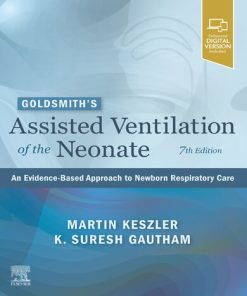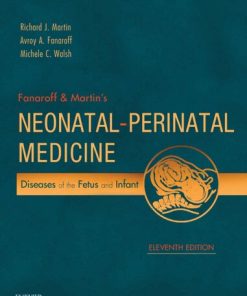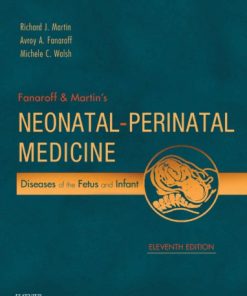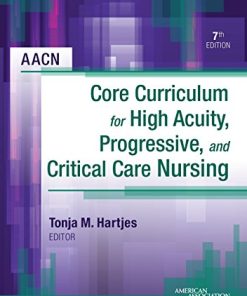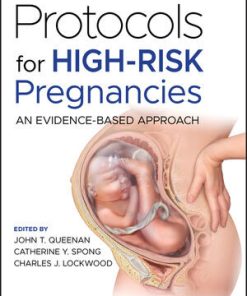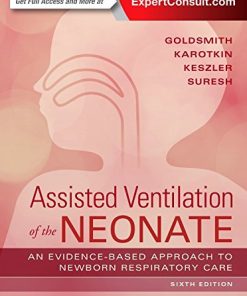(Ebook PDF) Klaus and Fanaroffs Care of the HighmRisk Neonate 7th Edition by Avroy Fanaroff 0323608566 9780323608565 full chapters
$50.00 Original price was: $50.00.$25.00Current price is: $25.00.
Klaus and Fanaroff’s Care of the High-Risk Neonate 7th Edition by Avroy A. Fanaroff – Ebook PDF Instant Download/DeliveryISBN: 0323608566, 9780323608565
Full dowload Klaus and Fanaroff’s Care of the High-Risk Neonate 7th Edition after payment
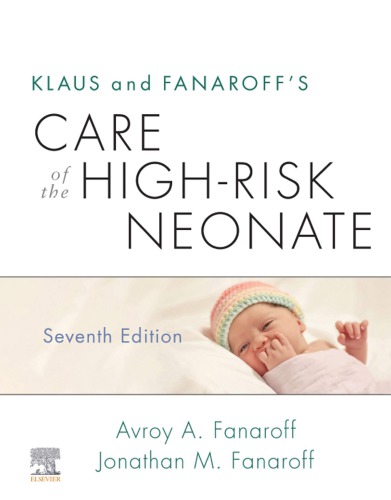
Product details:
ISBN-10 : 0323608566
ISBN-13 : 9780323608565
Author: Avroy A. Fanaroff
Klaus and Fanaroff’s Care of the High-Risk Neonate
Klaus and Fanaroff’s Care of the High-Risk Neonate 7th Table of contents:
1. Patient Safety, Quality, and Evidence-Based Medicine
Donabedian’s Triad and The Institute of Medicine’s Six Domains of Quality
Clinical Microsystems and How to Assess and Monitor The Quality of Care Provided
Why is Quality Improvement Important in Neonatal Care?
Improving the Quality of Care
Conclusions
2. Antenatal and Intrapartum Care of the High-Risk Infant
Identification of the Pregnancy at Risk
Selected Disorders of the Maternal–Fetal Interface
3. Resuscitation and Initial Stabilization
Fetal Transition to Extrauterine Life
4. Physical Growth: Physical Examination of the Newborn Infant and the Physical Environment
Determinants of Fetal Growth
Intrauterine Growth Restriction
Pattern of Fetal Growth
Antenatal Assessment of Intrauterine Growth
Epidemiology and Etiology of Fetal Growth Restriction
Placental Contributions
Diminished Potential: Fetal Contributions
Identification and Management of Growth Restriction
Small-for-Gestational-age Infants
Clinical Problems
The Preterm Growth-Restricted Infant
Growth and Long-Term Outcome
Large for Gestational Age
Physical Examination of the Newborn Infant
Observation
5. Nutrition and Selected Disorders of the Gastrointestinal Tract
Part 1: Nutrition for the High-Risk Infant
Introduction
Fluid
Electrolytes
Enteral Nutrition
Growth In the Neonatal Intensive Care Unit Influences Neurodevelopmental and Growth Outcomes
Method of Feeding
Human Milk
Premature Infant Formulas
Standard Infant Formulas
Soy Formula
Protein Hydrolysate Formula
Follow-Up Formula
Practical Hints for Enteral Nutrition
Nutritional Assessment
Questions
Part 2: Selected Disorders of the Gastrointestinal Tract
Duodenal Obstruction
Jejunoileal Anomalies
Malrotation/Volvulus
Meconium Ileus
Meckel Diverticulum
Colonic Lesions
Abdominal Wall Defects
Inguinal Hernia
Blood in Stool
Spontaneous Intestinal Perforation
Summary
Part 3: Necrotizing Enterocolitis
Clinical Features
6. Genetics, Inborn Errors of Metabolism, and Newborn Screening
History and Physical Examination
Birth Defects and Multiple Congenital Anomalies
Metabolic Issues
Abnormal Newborn Screen
Hepatosplenomegaly and Hydrops Fetalis
Neurological Presentations
Teratogens
Genetic Testing
7. Care of the Parents
Pregnancy
Labor and Delivery
Effects of Social and Emotional Support on Maternal Behavior
The Day of Delivery
Care of the Healthy Term Infant and Parents Following Birth
The Breast Crawl
Early and Extended Contact for Parents and Their Infant
The Sick or Premature Infant
Communicating Medical Information
Interventions for Families of Premature Infants: Family-Centered Care in The NICU
Congenital Malformations
Stillbirth or Death of A Newborn
Summary
8. Developmental Care—Understanding and Applying the Science
Introduction
Defining Developmental Care
The Evolution of Neonatal Neurodevelopmental Care
Brain Development: The Foundation of Behavior
Promoting Neuroprotection
The Eco-Bio-Developmental Framework
Trauma-Informed Care
The Importance of Touch and Social Connectedness
Benefits of Loving Touch
The Neonatal Integrative Model of Developmental Care
An Introduction to The Seven Core Measures
Understanding Effects of Room Design
Facilitating Noise Reduction and Promoting Auditory Development
Controlling Lighting and Visual Development
Protecting and Promoting Olfaction and Gustation
Evidenced-Based Therapeutic Interventions
The High-Risk Neonate and The Role of Neonatal Therapists
Interprofessional Collaboration
Demonstrated Impact of “High-Quality Developmental Care Programs”
Institutional Implementation of Developmental Neuroprotective Care
Systematic Reviews and Developmental Care
Recommendations for Future Research and Implications for Clinicians
Discussion
9. Respiratory Problems
Physiologic Considerations
Oxygen Delivery
Practical Considerations
Neonatal Problems
General Clinical Management
Persistent Pulmonary Hypertension of the Newborn
Meconium Aspiration Syndrome
Pneumothorax
Transient Tachypnea of the Newborn
Pulmonary Hemorrhage
Bronchopulmonary Dysplasia/Neonatal Chronic Lung Disease
Apnea in the Immature Infant
10. Assisted Ventilation
Respiratory Failure
Endotracheal Intubation
Applied Pulmonary Mechanics
Continuous Positive Airway Pressure
Mechanical Ventilation
Alternative Modes of Mechanical Ventilation
Carbon Dioxide Elimination
Oxygenation
Ventilator Setting Changes and Gas Exchange
Monitoring The Infant During Mechanical Ventilation
Special Circumstances
High-Frequency Ventilation
Complications of Assisted Ventilation
Extracorporeal Membrane Oxygenation
Summary
11. Glucose, Calcium, and Magnesium
Glucose
Mineral Disorders in the Neonate
12. Neonatal Hyperbilirubinemia
Formation, Structure, and Properties of Bilirubin
Bilirubin Measurement
Neonatal Bilirubin Metabolism
Normal Serum Bilirubin Levels and the Natural History of Neonatal Jaundice
Developmental Jaundice
An Approach to the Jaundiced Infant
Pathologic Jaundice
Other Causes of Increased Bilirubin Production or Load on the Liver
Bilirubin Toxicity
Clinical Management
Treatment
Phototherapy
Exchange Transfusion
Pharmacologic Treatment
13. Infections in the Neonate
Introduction
Bacteria and Fungi
Viruses
14. The Heart
Physiology and Pathophysiology
Physical Examination
Imaging in the Neonatal Intensive Care Unit
Diagnostic Groups of Congenital Heart Disease
Arrhythmias in the Neonate
15. The Kidney
Anatomic Development
Physiological Development
Renal Blood Flow
Glomerular Filtration Rate
Fluid Distribution
Sodium Handling
Plasma Osmolarity and Free Water Handling
Acid–Base Balance
Calcium And Phosphorus Balance
Evaluation
History
Physical Examination
Urinalysis
Laboratory Evaluation
Radiologic Evaluation
Specific Problems
Proteinuria
Acute Kidney Injury
Hypertension
Nephrocalcinosis
Renovascular Thrombosis
Congenital Kidney Disease
Hydronephrosis
16. Hematologic Problems
Red Blood Cells
Anemia
Polycythemia
Erythrocyte Transfusion in The Fetus and Newborn
White Blood Cells
Neutrophil Diseases
Eosinophilia
Chronic Granulomatous Disease
Neonatal Immune Deficiencies of Lymphocyte Lineage (T Cell, B Cell, Natural Killer Cell)
Neonatal Thrombocytopenia
Coagulation System in The Neonate
Bleeding in Neonates with Normal Platelet Counts
Thrombosis
17. Neonatal Brain Disorders
Brain Development in the Fetus and the Newborn
Neurological Examination of the Preterm and Term Born Infant
Brain Injury in the Preterm Infant
Neonatal Encephalopathy and Brain Injury in the Term Infant
Neurological Investigations in Term Neonatal Encephalopathy
Neurodevelopmental Correlates of Neuroimaging Patterns
Hypothermia and Patterns of Brain Injury
Neonatal Seizures
Hypotonia in the Term Infant—Neuromuscular Disorders
18. Neonatal Imaging
Imaging Modalities
Chest
Abdomen
Urinary Tract
Future Directions
Key Points
19. The Outcome of Neonatal Intensive Care
Importance of Follow-Up for High-Risk Infants
Minor Transient Problems
Transient Neurologic Abnormality
Persistent Neurologic Sequelae
Physical Sequelae and Chronic Disease
Physical Growth
Follow-Up—Who, What, How, and When
Timing of Follow-Up Visits
Neurosensory and Developmental Assessment
Early Intervention
Points to Remember
Early Childhood Outcomes
School-Age Outcomes
Young Adult Outcomes
20. Ethical Issues
What/Who Defines the Limits of Viability, and Must All These Infants Born at the Limits of Viability be Resuscitated?
What Delivery Options Should be Offered to the Woman? Should She be Offered Prenatal Steroids? Should She be Offered A Monitored Delivery? is it Appropriate to Offer A Cesarean Section for A Fetal Indication?
Who should Make Decisions Regarding Forgoing Resuscitation or Treatment of an Infant in the Periviable Peri
People also search for Klaus and Fanaroff’s Care of the High-Risk Neonate 7th:
can klaus have another baby
does klaus keep his baby
does klaus have a baby
does klaus have a baby with camille
care of the high risk neonate
You may also like…
Uncategorized
Politics & Philosophy - Sociology
Medicine - Others



